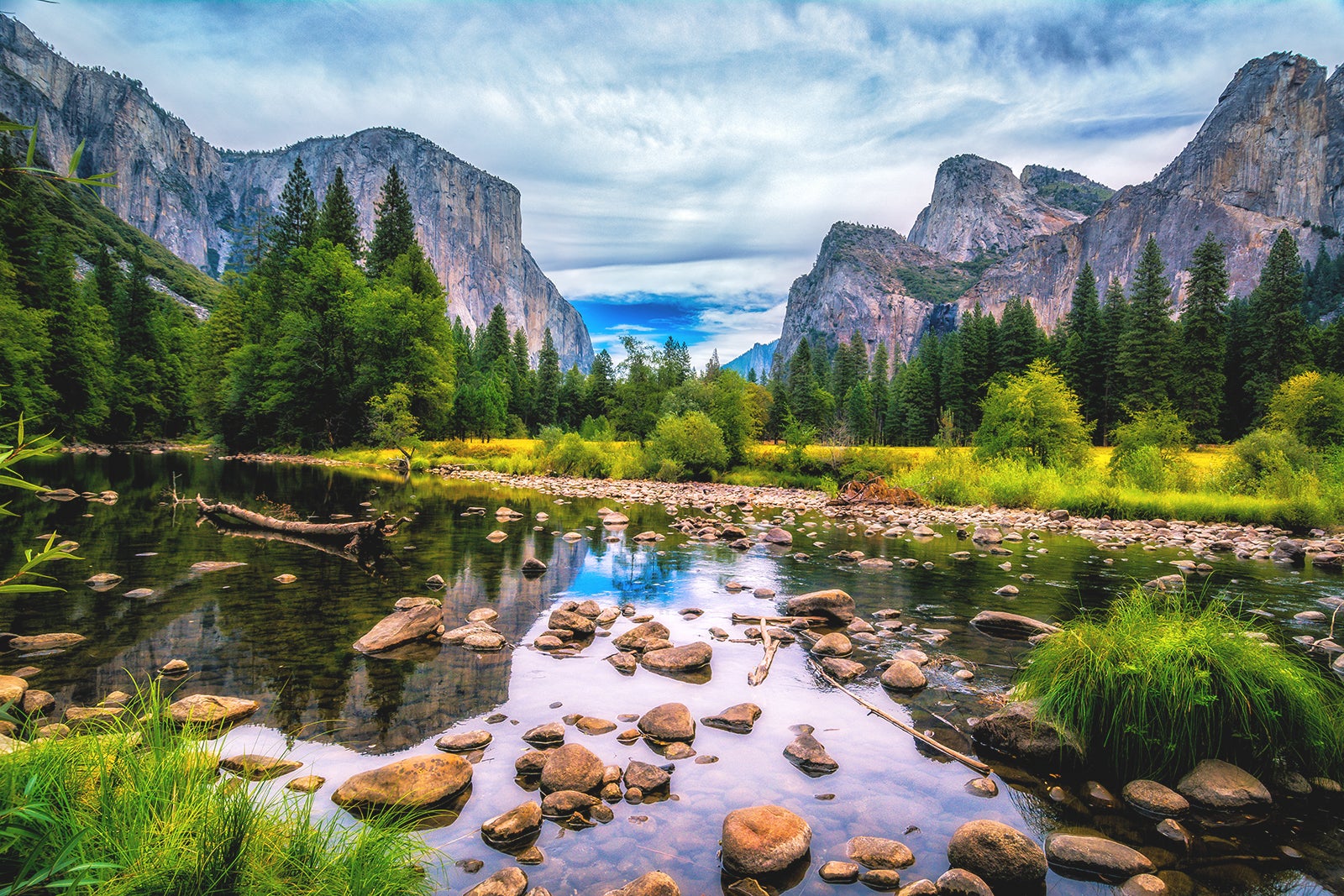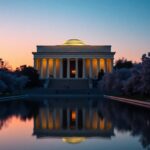With its towering granite cliffs, majestic waterfalls, and ancient giant sequoias, Yosemite National Park offers you an unparalleled opportunity to witness some of America’s most breathtaking natural wonders. As you explore this vast landscape, your camera will capture iconic scenes like El Capitan and Half Dome, ensuring your memories reflect the park’s grandeur. Whether you’re hiking, photographing, or simply soaking in the views, Yosemite invites you to connect deeply with nature’s artistry and preserve its timeless beauty through your own perspective.
Key Takeaways:
- Yosemite National Park is home to some of America’s most famous natural landmarks, including El Capitan, Half Dome, and Yosemite Falls.
- The park offers diverse landscapes, from granite cliffs and giant sequoias to lush meadows and pristine rivers.
- Visitors can engage in a variety of activities such as hiking, rock climbing, photography, and wildlife observation.
- Yosemite’s stunning vistas provide exceptional opportunities for capturing breathtaking images of nature’s beauty.
- Preservation efforts ensure the park’s natural masterpieces remain protected for future generations to enjoy.
Yosemite National Park: Capture America’s Most Iconic Natural Masterpieces
| Feature/Fact | Description |
|---|---|
| Location | Sierra Nevada Mountains, California, USA |
| Established | October 1, 1890 |
| Area | 1,187 square miles (3,081 km²) / 748,542 acres |
| UNESCO Status | World Heritage Site |
| Iconic Landmarks | Yosemite Valley, El Capitan, Half Dome, Bridalveil Fall, Mariposa Grove, Tuolumne Grove |
| Major Waterfalls | Yosemite Falls (2,425 ft/739 m, tallest in North America), Bridalveil Fall, Horsetail Fall |
| Highest Peak | Mount Lyell (13,114 ft / 3,997 m) |
| Granite Cliffs | El Capitan (3,000 ft/914 m above valley floor), Half Dome |
| Giant Sequoias | Mariposa Grove, Tuolumne Grove (trees over 2,000 years old, up to 275 ft tall, 21 ft diameter) |
| Ecosystems | Lush meadows, dense forests, high alpine regions |
| Wildlife | 40 amphibians/reptiles, 242 birds, 11 fish, 77 mammals |
| Flora | 1,400 flowering plants, 37 tree species |
| Lakes | 318 (127 with fish, 191 without) |
| Rivers & Streams | 880 miles |
| Developed Trails | 800 miles |
| Campsites | 1,445 individual sites |
| Overnight Accommodations | 1,729 units |
| Paved Roads | 360 miles |
| Weather (Yosemite Valley) | Summer highs: 82–90°F (28–32°C); Winter lows: 26–31°F (-3 to -1°C); Rainiest: Jan–Mar |
| Historic Milestones | 1864: Yosemite Grant signed by Lincoln; 1890: National Park established; 1906: Valley & Mariposa Grove added |
| Notable Conservationists | John Muir, Galen Clark |
| Best Time for Waterfalls | Late fall to midsummer (peak in May) |
| Visitor Experience | Shuttle system, paved paths, biking, hiking, wildlife viewing, photography |
Highlights
-
Yosemite is famed for its colossal granite cliffs, dramatic waterfalls, and ancient sequoia groves, making it a quintessential symbol of America’s natural heritage136.
-
The park’s unique geology and biodiversity attract millions of visitors annually, offering spectacular vistas and recreational opportunities year-round136.
-
Conservation efforts led by figures like John Muir and Galen Clark were pivotal in establishing Yosemite as a model for the national park system25.
-
Seasonal phenomena like the “firefall” effect at Horsetail Fall and the glowing cliffs at sunset are must-see spectacles6.
-
Yosemite Valley remains the heart of the park, with easy access to its most iconic sights and a range of visitor amenities34.
Capture why Yosemite National Park stands as one of America’s most iconic natural masterpieces.
Capturing Yosemite Valley’s Visual Masterpieces
Yosemite Valley offers countless opportunities to capture stunning landscapes, with towering granite cliffs and serene waterways forming a dramatic backdrop. Each vantage point provides unique lighting and perspective, so timing your shoot around sunrise or sunset enhances depth and shadow play, revealing textures on El Capitan and Half Dome that cameras love. Using a wide-angle lens can help capture sweeping views, while telephoto lenses emphasize intricate details, allowing you to create a portfolio that reflects both the grandeur and intimacy of Yosemite’s majestic valley.
Iconic Vistas: Tunnel View, El Capitan Meadow, and Sentinel Bridge
Tunnel View delivers that classic Yosemite postcard shot, framing El Capitan, Bridalveil Fall, and Half Dome in a single breathtaking panorama. At El Capitan Meadow, you can photograph climbers scaling the granite monolith, adding human scale to the scene. Sentinel Bridge conveniently places Half Dome’s reflection in the Merced River, creating mirror-like symmetry best captured in the calm morning hours. Each location demands attention to light direction and weather, offering diverse moods from misty mornings to golden hour glows.
The Story Behind Each Shot: Composing the Perfect Frame
Composition in Yosemite often revolves around balancing natural elements — rock formations, trees, water reflections — while leading the viewer’s eye through the image. Positioning key landmarks using the rule of thirds or framing with foreground elements adds depth and context. Incorporating movement, like flowing waterfalls or drifting clouds, introduces dynamism within otherwise static scenes. Thoughtful framing turns every photograph into a narrative that highlights your personal journey through this iconic landscape.
Delving deeper into composition, consider how light changes Yosemite’s features throughout the day. The granite of El Capitan, for example, transitions from warm golden hues at dawn to stark, contrasting greys at midday, dramatically altering mood. Foregrounds such as wildflowers in spring or autumnal foliage enrich your images with seasonal character. Experimenting with perspectives — shooting low to include river reflections or climbing to overlook vantage points — makes your photographs uniquely yours. Planning your shots around weather patterns, such as post-rain mist or clear starry skies, enhances storytelling and emotional impact.
The Allure of Yosemite’s Waterfalls
Yosemite’s waterfalls present an ever-changing spectacle that draws photographers year-round. Their dynamic flow patterns narrate the park’s seasonal rhythms—from the roaring torrents of spring meltoffs to the delicate trickle in late summer. Each cascade cuts through granite cliffs with mesmerizing force and grace, offering you endless compositional possibilities. Capturing their sheer scale and fluid motion amidst the surrounding wilderness requires both technical finesse and a creative eye to translate nature’s raw energy into evocative images.
Seasonal Highlights: Yosemite Falls, Vernal Fall, and Bridalveil Fall
Yosemite Falls commands attention with up to 2,425 feet of descending water during peak snowmelt, embodying power in spring and early summer. Vernal Fall’s misty spray creates vibrant rainbows along the Mist Trail, offering magical morning light conditions. Bridalveil Fall, consistently flowing year-round, entices you with its dramatic plunge and ethereal veil-like appearance, especially vivid in the golden hours. Each waterfall’s character shifts with the seasons, so timing your visit can dramatically influence the mood and visual narrative you craft.
Techniques for Capturing Water Magic: Timing and Creative Angles
Long exposure photography unlocks the silky smooth textures of cascading water, achieved by using shutter speeds between 1 and 4 seconds—capturing your waterfall’s movement while maintaining sharp surroundings. Experiment with various vantage points to frame the falls against contrasting cliffs, lush foliage, or reflective pools. Early mornings and late afternoons provide soft light that enriches color and minimizes harsh shadows, enhancing water’s natural glow and texture. Your awareness of light direction and speed allows you to convey the falls’ dynamic energy effectively.
Delving deeper into compositional strategies, combining foreground elements like mossy rocks or wildflowers adds depth and scale to your waterfall shots. Adjusting your perspective—shooting from below emphasizes height and grandeur, while side angles capture the intricate patterns carved into the rock face. Neutral density filters can help reduce light allowing for longer exposures in bright conditions, smoothing water and heightening mood. Bracketing exposures may also enable you to create HDR images, balancing highlights and shadows to reveal details in both water and terrain. These techniques enable you to transform a familiar waterfall into a truly unique masterpiece.
The Magic of Light: Golden Hours and Night Skies
The interplay of light during Yosemite’s golden hours transforms its majestic landscapes into poetic scenes bursting with color and depth. Early mornings and late afternoons bathe the granite cliffs and meadows in warm, soft hues, enhancing textures and creating dramatic contrasts. As day turns to night, the park’s minimal light pollution unveils a dazzling, star-studded sky, offering an unparalleled opportunity for capturing astrophotography masterpieces. This natural lighting panorama invites you to explore creative expressions, from glowing sunrises to the Milky Way arching above iconic silhouettes like Half Dome.
Best Locations for Ultimate Sunrise and Sunset Shots
Glacier Point reigns supreme for vibrant sunrise photography, as the sun’s first rays paint El Capitan and Yosemite Valley in luminous golds and reds. Tunnel View offers a panoramic stage perfect for sunset, where the fading light caresses Bridalveil Fall and Half Dome with fiery tones. Taft Point’s expansive views allow you to frame the sun dipping behind sheer cliffs, creating breathtaking silhouettes. These vantage points deliver outstanding compositions by harnessing the dynamic shifts of light that define Yosemite’s unforgettable visual moods.
Mastering Astrophotography: Gear, Tips, and Tricks
Capturing Yosemite’s night sky requires a blend of precise gear and thoughtful technique. Wide-aperture lenses (f/2.8 or faster) paired with full-frame cameras excel at gathering faint starlight. A sturdy tripod eliminates blur during long exposures, while a remote shutter release or timed delay reduces vibration. Setting ISO between 1600 and 3200 balances noise and brightness, and using exposures of 20 seconds or less prevents star trailing. Manual focus calibrated to infinity ensures sharp stars, and shooting in RAW format maximizes post-processing flexibility. The park’s dark skies reward patient composition and experimenting with foreground elements for stunning astrophotography.
Expanding your astrophotography arsenal and techniques enhances the quality of your captures. Consider these additional points:
-
- Use a star tracker for extended exposures that reveal intricate celestial details without trails.
- Scout dark spots away from any artificial light, such as near the Tuolumne Meadows, to maximize sky clarity.
- Take advantage of moonless nights to highlight the Milky Way’s galactic core in vivid detail.
- The integration of time-lapse photography can showcase the dynamic movement of stars across the night sky.
- Calibrating white balance to daylight or cooler tones maintains the natural color balance of the stars and the landscape under the night sky.
The mastery of these elements allows you to delicately balance exposure, detail, and composition for impactful night sky images in Yosemite.
Seasonal Transformations: A Photographer’s Perspective
Observing Yosemite through your lens across different seasons reveals an ever-changing masterpiece. Winter cloaks Half Dome in pristine snow, casting long shadows that highlight its rugged contours. Spring ushers in cascading waterfalls fed by melting snow, vibrant wildflowers, and a fresh luminosity ideal for close-ups. Summer’s golden hours paint El Capitan with warm hues, while autumn blankets the valley in fiery reds and oranges, perfect for atmospheric landscapes. Adjusting your approach to these seasonal variations allows you to capture Yosemite’s dynamic beauty with depth and authenticity.
The Canvas of the Seasons: Winter, Spring, Summer, and Fall
Winter’s soft blankets of snow transform Yosemite into a serene monochrome setting, emphasizing dramatic silhouettes against pale skies. Spring awakens the valley with vibrant greens and rushing waters, ideal for capturing movement and renewal. Summer offers extended daylight and clear vistas, allowing you to experiment with wide-angle compositions of iconic granite cliffs. Fall’s palette bursts with warm reds and yellows from deciduous trees, infusing your images with rich contrast and texture, making each season a unique canvas for your creative vision.
Color Theory and Lighting: What Works Best When
Golden hours around sunrise and sunset maximize warm tones that amplify autumn’s fiery foliage and summer’s granite glow. In winter, the diffused light from overcast skies softens shadows, enhancing the subtle blues and whites of snow-covered landscapes. Spring’s dynamic lighting balances warm sunrises with vibrant greens, so mid-morning can provide clarity without harsh contrast. Understanding how color temperature shifts with light and season enables you to anticipate hues and contrast, guiding your exposure and filter choices.
Diving deeper into color theory, the contrast between warm and cool tones shapes the mood of your photographs significantly. During autumn, the interplay between the warm reds and oranges of leaves against the cool granite or blue sky creates compelling complementary color schemes. In winter, cooler blue tones dominate, but intermittent sunlight introduces clusters of warm light that add dimension. Adjusting your white balance settings can either enhance these contrasts or create a specific atmosphere. For example, setting a slightly warmer white balance during snowy mornings can evoke a cozy, inviting feeling, while cooler settings emphasize crispness and clarity. Layering this understanding with natural seasonal light variations helps you produce visually striking images that resonate emotionally with viewers.
Off-the-Beaten-Path: Hidden Gems Worth Exploring
Exploring beyond Yosemite’s well-trodden paths rewards you with breathtaking views and tranquil settings rarely captured by the crowd. Seeking out secluded groves and lesser-known trails reveals a quieter, intimate side of the park. These hidden gems offer unique lighting and perspectives, perfect for capturing images that stand apart from typical postcard shots. Whether winding along less popular trails or discovering secret vantage points, your exploration expands the breadth of Yosemite’s visual story.
Discovering Secluded Spots: Cathedral Lakes and Tenaya Lake
Cathedral Lakes, nestled below Cathedral Peak, provides crystal-clear reflections and dramatic granite backdrops, a joy to shoot during sunrise. Just a short drive away, Tenaya Lake’s serene waters mirror towering pines and distant cliffs, offering stunning contrasts that change with shifting light. These locations grant you peaceful solitude and exceptional photographic opportunities, especially when early morning mists or golden hour hues transform the landscape into a living canvas.
Equipment Recommendations for Diverse Landscapes
A versatile lens kit enhances your ability to capture Yosemite’s varied scenery. Wide-angle lenses, like a 16-35mm, excel for expansive valley views and dynamic skies, while a 70-200mm telephoto lens isolates distant peaks or wildlife. A sturdy tripod supports low-light or long-exposure shots, crucial near waterfalls or at dusk. Additionally, including a polarizing filter helps manage reflections on lakes and deepens sky colors, making your images more vivid and striking.
Carrying a range of lenses allows you to adapt quickly to Yosemite’s shifting landscapes—from towering cliffs to delicate wildflowers. A wide-angle lens captures the grandeur of Half Dome in full scale, while telephoto lenses highlight texture and detail in rock faces or distant wildlife encounters. Investing in a lightweight yet stable tripod aids in shooting crisp images during long exposures, especially around misty waterfalls like Vernal Fall. Keep polarizing and neutral density filters handy to control glare and balance exposures during bright conditions, ensuring every frame maximizes the park’s natural beauty.
The Art of Post-Processing: Enhancing Natural Beauty
Your raw photos from Yosemite often capture the park’s grandeur but refining these images through post-processing truly brings out the subtle details and vibrant hues. Adjusting exposure precisely can reveal hidden textures in the granite cliffs or the soft shadows under towering trees. Balancing highlights and shadows preserves the dynamic range of scenes like the misty waterfalls of Yosemite Valley, ensuring your images retain natural authenticity while emphasizing depth and contrast.
Crafting the Right Aesthetic: Earthy vs. High-Contrast Edits
Deciding between earthy and high-contrast edits shapes the mood of your Yosemite shots. Earthy tones highlight the park’s organic textures with muted greens and warm browns that echo the environment’s natural palette. Conversely, high-contrast edits intensify the drama in scenes like sun-dappled cliffs, pushing blacks deeper and whites brighter. Experiment with saturation and clarity sliders to find the balance that resonates with your vision—whether you want to evoke calm serenity or bold intensity.
Presets and Techniques That Define the Yosemite Experience
Using presets inspired by Yosemite’s landscapes can streamline your editing workflow and deliver consistent results. Look for presets that enhance clarity and vibrance subtly without oversaturating natural colors. Techniques such as gradient filters mimic the park’s shifting light, especially during sunrise over Half Dome or the golden hour below El Capitan, adding dimensionality to your frames.
Diving deeper into presets, those tailored for Yosemite often emphasize tonal nuances like the soft hues of lupine fields and the rich granite textures. Incorporating graduated filters enhances skies, bringing out the blue gradients that clash beautifully with rugged rock faces. Layering local adjustments allows accentuating details, such as sharpening tree bark or highlighting water spray, ensuring each image reflects the vivid experience Yosemite offers. These methods make your portfolio more immersive and authentic.
Summing up
Upon reflecting on Yosemite National Park, you come to appreciate its unparalleled beauty and the iconic natural masterpieces that define America’s wilderness. From majestic granite cliffs to serene waterfalls, your visit offers endless opportunities to connect with nature and capture breathtaking moments. Embrace the grandeur that surrounds you, and allow Yosemite to inspire your sense of adventure and admiration for the environment. By exploring this extraordinary landscape, you deepen your understanding of the natural world and create memories that will stay with you forever.
Q: What are some must-see natural landmarks in Yosemite National Park?
A: Yosemite National Park is renowned for its breathtaking landmarks such as El Capitan, a massive granite monolith popular with rock climbers; Half Dome, a striking rock formation offering challenging hikes and stunning views; Yosemite Falls, one of the tallest waterfalls in North America; and Glacier Point, which provides panoramic vistas of Yosemite Valley, including its famous cliffs and waterfalls.
Q: When is the best time to visit Yosemite National Park for photography?
A: The ideal time for photography in Yosemite varies depending on what you want to capture. Spring is perfect for photographing waterfalls at their peak flow, while autumn offers vibrant fall foliage combined with fewer crowds. Summer provides clear skies and accessible trails, but it can be busy. Winter brings snow-covered landscapes, offering unique shots of the park’s iconic granite formations contrasted against white snow.
Q: Are there specific spots in Yosemite recommended for sunrise or sunset photography?
A: Yes, Yosemite offers numerous fantastic locations for sunrise and sunset shots. Tunnel View is famous for its sweeping views of El Capitan, Half Dome, and Bridalveil Fall during these times. Glacier Point is another excellent spot, especially at sunset, where the fading light casts beautiful colors over Yosemite Valley. Sentinel Dome also provides a stunning 360-degree view that is captivating during both sunrise and sunset.
Q: What preparation should photographers consider when visiting Yosemite National Park?
A: Photographers should prepare by packing appropriate gear such as wide-angle and telephoto lenses to capture diverse scenes, sturdy tripods for low-light conditions, and weather-appropriate clothing. It’s important to check the park’s current conditions and regulations, plan for early arrivals to avoid crowds, and bring sufficient water and snacks. Additionally, ensuring batteries and memory cards are fully charged will help capture extensive photos during the trip.
Q: Can visitors easily access Yosemite’s iconic viewpoints and trails?
A: Many of Yosemite’s famous viewpoints are accessible by road and have parking areas, such as Tunnel View and Glacier Point. Some trails, like the hike to Mirror Lake or the base of Yosemite Falls, are suitable for most visitors and offer close-up experiences with the park’s natural beauty. However, more challenging hikes like Half Dome require permits and physical fitness. Visitors should check trail conditions and accessibility to plan accordingly.
- https://travellersguides.com/eco-friendly-travel-hacks/
- https://sevennaturalwonders.org/north-america/yosemite-national-park/
- https://yosemiteresorts.com/yosemite-historic-landmarks/
- https://www.yosemite.com/yosemite-mariposa-stories/yosemite-facts/
- https://wildlandtrekking.com/visiting-yosemite/must-see-highlights-of-yosemite/
- https://en.wikipedia.org/wiki/History_of_the_Yosemite_area
- https://route66rv.com/visit-yosemite-national-park/
- https://www.nps.gov/yose/learn/nature/naturalfeaturesandecosystems.htm
- https://www.yosemite.com/things-to-do/iconic-locations/
- https://www.myyosemitepark.com/things-to-do/natural-wonders/
- https://www.nps.gov/yose/planyourvisit/basicinfo.htm






